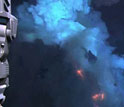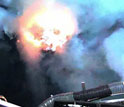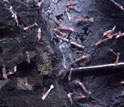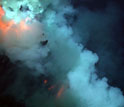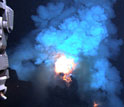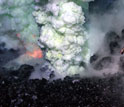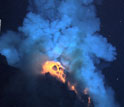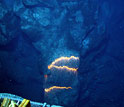News Release 09-243
Marine Scientists Discover Deepest Undersea Erupting Volcano
Spectacular West Mata Volcano shown in newly released video, images
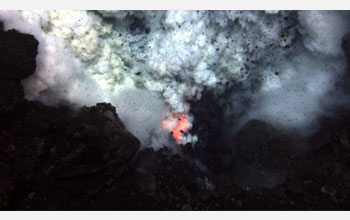
An explosion at the West Mata Volcano throws ash and rock, with molten lava glowing below.
December 17, 2009
View videos (clip1, clip2) of the undersea eruption of the West Mata volcano.
This material is available primarily for archival purposes. Telephone numbers or other contact information may be out of date; please see current contact information at media contacts.
Scientists funded by the National Science Foundation (NSF) and NOAA have recorded the deepest erupting volcano yet discovered--West Mata Volcano--describing high-definition video of the undersea eruption as "spectacular."
"For the first time we have been able to examine, up close, the way ocean islands and submarine volcanoes are born," said Barbara Ransom, program director in NSF's Division of Ocean Sciences. "The unusual primitive compositions of the West Mata eruption lavas have much to tell us."
The volcanic eruption, discovered in May, is nearly 4,000 feet below the surface of the Pacific Ocean, in an area bounded by Fiji, Tonga and Samoa.
"We found a type of lava never before seen erupting from an active volcano, and for the first time observed molten lava flowing across the deep-ocean seafloor," said the expedition's chief scientist Joseph Resing, a chemical oceanographer at the University of Washington.
"It was an underwater Fourth of July, a spectacular display of fireworks nearly 4,000 feet deep," said co-chief scientist Bob Embley, a marine geologist at NOAA's Pacific Marine Environmental Laboratory in Newport, Ore.
"Since the water pressure at that depth suppresses the violence of the volcano's explosions, we could get an underwater robot within feet of the active eruption. On land, or even in shallow water, you could never hope to get that close and see such great detail."
Imagery includes large molten lava bubbles three feet across bursting into cold seawater, glowing red vents exploding lava into the sea, and the first-observed advance of lava flows across the deep-ocean floor.
Sounds of the eruption were recorded by a hydrophone and later matched with the video footage.
Expedition scientists released the video and discussed their observations at a Dec. 17 news conference at the American Geophysical Union (AGU)'s annual fall meeting in San Francisco.
The West Mata Volcano is producing boninite lavas, believed to be among the hottest on Earth in modern times, and a type seen before only on extinct volcanoes more than one million years old.
University of Hawaii geochemist Ken Rubin believes that the active boninite eruption provides a unique opportunity to study magma formation at volcanoes, and to learn more about how Earth recycles material where one tectonic plate is subducted under another.
Water from the volcano is very acidic, with some samples collected directly above the eruption, the scientists said, as acidic as battery acid or stomach acid.
Julie Huber, a microbiologist at the Marine Biological Laboratory, found diverse microbes even in such extreme conditions.
Tim Shank, a biologist at the Woods Hole Oceanographic Institution (WHOI), found that shrimp were the only animals thriving in the acidic vent water near the eruption. Shank is analyzing shrimp DNA to determine whether they are the same species as those found at seamounts more than 3,000 miles away.
The scientists believe that 80 percent of eruptive activity on Earth takes place in the ocean, and that most volcanoes are in the deep sea.
Further study of active deep-ocean eruptions will provide a better understanding of oceanic cycles of carbon dioxide and sulfur gases, how heat and matter are transferred from the interior of the Earth to its surface, and how life adapts to some of the harshest conditions on Earth.
The science team worked aboard the University of Washington's research vessel Thomas Thompson, and deployed Jason, a remotely-operated vehicle owned by WHOI.
Jason collected samples using its manipulator arms, and obtained imagery using a prototype still and HD imaging system developed and operated by the Advanced Imaging and Visualization Lab at WHOI.
Other expedition participants were affiliated with Oregon State University, Monterey Bay Aquarium Research Institute, Western Washington University, Portland State University, Harvard University, the University of Tulsa, California State University's Moss Landing Marine Laboratory, the University of California Santa Cruz and Lamont Doherty Earth Observatory.
-NSF-
-
View Video
Bubbles of gas-rich magma burst, spewing lava fragments into the water.
Credit and Larger Version -
View Video
A sequence of closer views of the eruption, with bright flashes of hot magma.
Credit and Larger Version -
Shrimp congregate near the summit of West Mata Volcano, withstanding hot, acid waters.
Credit and Larger Version -
An eruptive blast at West Mata Volcano, with superheated pillow lava flowing downslope.
Credit and Larger Version -
A bright flash of hot magma is blown up into the water before settling back to the seafloor.
Credit and Larger Version -
The orange glow of magma in an eruptive area the length of a football field along the summit.
Credit and Larger Version -
Superheated molten lava, about 2200 degrees Fahrenheit, is about to explode into the water.
Credit and Larger Version -
A pillow lava tube extends downslope in an area about three feet across.
Credit and Larger Version
Media Contacts
Cheryl Dybas, NSF, (703) 292-7734, email: cdybas@nsf.gov
Fred Gorell, NOAA, (301) 734-1021, email: fred.gorell@noaa.gov
The U.S. National Science Foundation propels the nation forward by advancing fundamental research in all fields of science and engineering. NSF supports research and people by providing facilities, instruments and funding to support their ingenuity and sustain the U.S. as a global leader in research and innovation. With a fiscal year 2023 budget of $9.5 billion, NSF funds reach all 50 states through grants to nearly 2,000 colleges, universities and institutions. Each year, NSF receives more than 40,000 competitive proposals and makes about 11,000 new awards. Those awards include support for cooperative research with industry, Arctic and Antarctic research and operations, and U.S. participation in international scientific efforts.
Connect with us online
NSF website: nsf.gov
NSF News: nsf.gov/news
For News Media: nsf.gov/news/newsroom
Statistics: nsf.gov/statistics/
Awards database: nsf.gov/awardsearch/
Follow us on social
Twitter: twitter.com/NSF
Facebook: facebook.com/US.NSF
Instagram: instagram.com/nsfgov



